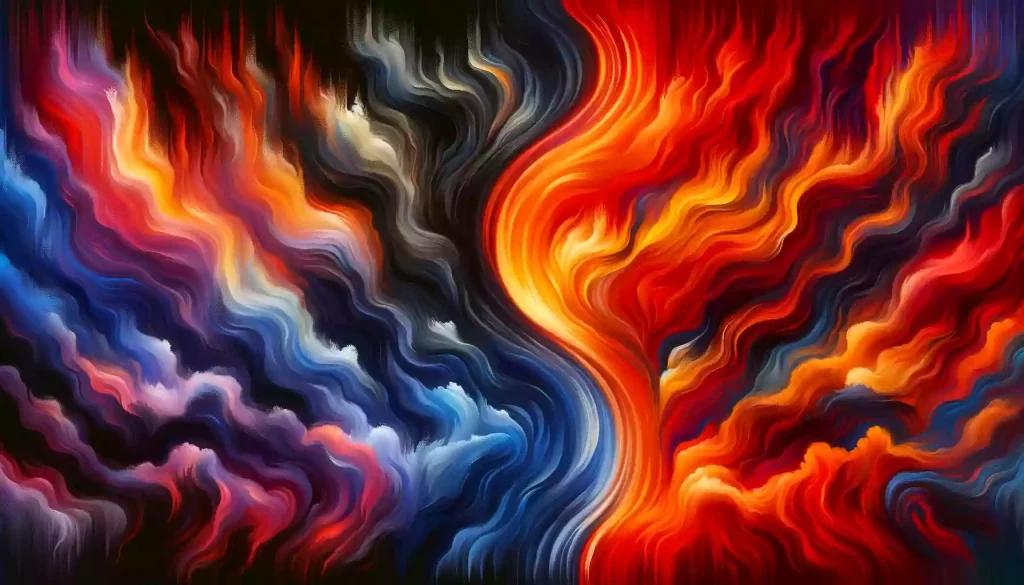Key Takeaways:
- Exploring the dynamic emotion spectrum
- Impact of communication on relationships
- Understanding shifts from love to hate
- Strategies for maintaining emotional balance
Understanding the Thin Line
The concept of a fine line separating love and hate is not just a poetic metaphor but a reflection of the complex nature of human emotions. This article delves into the nuanced relationship between these two intense feelings. We begin by exploring the psychological underpinnings that connect and distinguish love from hate.
Often, the transition from deep affection to aversion can be subtle and gradual, leaving individuals bewildered by their changing emotions. This transition is influenced by various factors, including communication, personal experiences, and external stresses. Understanding these factors can provide insights into the perplexing nature of our emotions.
Love and hate are not just personal experiences; they are also shaped by societal norms and cultural backgrounds. Our interpretation of these emotions and how we express them are deeply rooted in our upbringing and the societal context we live in. This article aims to shed light on these aspects, offering a holistic view.
The intensity of love and hate makes them potent forces in human relationships. While love can be nurturing and supportive, hate can be destructive and alienating. However, the line between them is often blurred, making it crucial to recognize the signs of shifting feelings.
As we explore this topic, we will also delve into personal stories and expert insights, offering a diverse range of perspectives on the line between love and hate. These narratives will provide real-life examples of how people navigate this complex emotional terrain.
Understanding the line between love and hate is essential for emotional growth and the health of our relationships. This exploration is not just about recognizing the differences but also about finding ways to balance these powerful emotions in our lives.
1. The Psychology Behind Love and Hate
The psychological relationship between love and hate is intriguing and multifaceted. At their core, both emotions are deeply rooted in our human need for connection and recognition. Psychologists suggest that these emotions are two sides of the same coin, with a thin line separating them.
Love is often driven by admiration, respect, and a deep sense of connection with another person. It thrives on mutual understanding and shared experiences. Conversely, hate can stem from a sense of betrayal, disappointment, or hurt. It's often a defensive reaction to protect oneself from perceived threats.
Interestingly, the intensity of these emotions can make them interchangeable under certain circumstances. For instance, a deeply loved one's slight betrayal can evoke intense feelings of hate, highlighting the fragile nature of our emotional responses.
This section of the article will further explore the psychological theories that explain the close link between love and hate, providing a foundation for understanding the complexities of these emotions.
2. How Passion Transforms into Resentment

Passion, often seen as the bedrock of intense relationships, can sometimes take a dark turn into resentment. This transformation is neither abrupt nor unidirectional but is a gradual process influenced by multiple factors, including unmet expectations and communication breakdowns.
Initially, passion fuels a relationship with intensity and a deep sense of connection. However, when this intensity is not matched with mutual respect and understanding, it can lead to feelings of neglect and disappointment. Over time, these negative feelings can accumulate, overshadowing the initial passion.
One of the key aspects of this transformation is the perception of imbalance. When one partner feels that their emotional investments are not reciprocated, it can lead to a sense of unfairness and eventually, resentment. This is particularly true in relationships where communication is lacking or ineffective.
Resentment can also stem from unaddressed conflicts or unresolved issues. When problems are not openly discussed and resolved, they can fester and erode the foundation of love and passion that the relationship was built upon.
This section of the article will delve deeper into the psychology of how passion can turn into resentment, offering insights into how to recognize and address these changes in a relationship. The goal is to provide readers with tools to nurture their relationships and prevent the decay of passion into resentment.
3. The Role of Communication in Balancing Emotions
Communication is the cornerstone of any relationship, acting as a balancing force between love and hate. It is through effective communication that couples can navigate the complexities of their emotions, preventing misunderstandings and fostering a deeper understanding.
Open and honest communication allows partners to express their feelings, desires, and concerns in a safe environment. It helps in acknowledging each other's perspectives and in finding common ground even in the midst of disagreements.
However, communication is not just about verbal exchanges. Non-verbal cues, such as body language and emotional expressions, play a significant role in conveying feelings and intentions. Being attuned to these subtle signals can enhance understanding and empathy in a relationship.
Challenges arise when communication breaks down, either due to external stresses or internal conflicts. This breakdown can lead to assumptions and misinterpretations, fueling negative emotions like frustration and anger.
The article will explore various communication strategies that can help maintain emotional balance in relationships. These strategies include active listening, expressing emotions constructively, and learning to navigate conflicts in a healthy manner.
Additionally, the role of professional help, such as couple's therapy, will be discussed. Sometimes, having a neutral third party can provide the necessary guidance to improve communication and understand each other's emotional needs.
This section emphasizes the pivotal role of communication in sustaining love and mitigating hate, providing practical advice for couples to enhance their emotional connection and resolve conflicts effectively.
4. Recognizing the Signs of Shifting Feelings

Identifying the signs of shifting feelings in a relationship is crucial for addressing underlying issues before they escalate. These signs are often subtle and can manifest in various ways, from changes in communication patterns to emotional withdrawal.
One of the first signs is a noticeable decrease in open and affectionate communication. This may include fewer conversations about each other's day, a lack of interest in shared activities, or avoiding deep conversations. These changes can signal a growing emotional distance.
Another indicator is the change in physical intimacy. This doesn't just refer to sexual activity but also to everyday physical gestures like holding hands, hugging, or casual touches. A reduction in these gestures can be a sign of cooling affections.
Emotional withdrawal is also a key sign. This may involve one partner becoming more self-contained, less emotionally expressive, or seemingly indifferent to the other's needs or feelings. Such withdrawal can create a feeling of loneliness within the relationship.
Conflict patterns may also change. While healthy disagreements are normal, an increase in trivial conflicts or, conversely, a complete avoidance of any conflict can indicate problems. Both extremes suggest issues with handling emotions and communicating effectively.
This section of the article will delve deeper into these signs, helping readers to recognize and understand the dynamics of shifting feelings in their relationships. It will also offer guidance on how to address these changes constructively.
5. The Impact of External Stress on Relationships
External stressors, ranging from work-related pressures to family obligations, can significantly impact relationships. These stressors can strain the emotional bond between partners, leading to increased conflict and reduced feelings of love and affection.
Work stress, for instance, can spill over into the relationship, with one or both partners becoming irritable, withdrawn, or less communicative. This can create a cycle of stress and conflict, further exacerbating relationship tensions.
Family obligations, such as caring for children or elderly relatives, can also place a heavy burden on relationships. The time and energy required for these responsibilities can leave little room for nurturing the romantic relationship.
This section will explore how external stressors affect relationships and offer strategies for couples to manage these challenges. It will emphasize the importance of teamwork, communication, and mutual support in overcoming external pressures and maintaining a healthy relationship.
Navigating Through the Complexities of Love and Hate

Navigating the complexities of love and hate is akin to traversing a landscape filled with unpredictable terrain. Understanding and managing these emotions requires self-awareness, empathy, and a willingness to confront challenging feelings.
It begins with self-reflection, where individuals assess their feelings and motivations. This introspection helps in understanding why certain emotions arise, making it easier to address them effectively.
Empathy plays a crucial role in this journey. By putting oneself in the other's shoes, one can gain perspective on why certain actions or words might trigger love or hate. This understanding can lead to more compassionate and constructive interactions.
Communication, as previously discussed, is vital. It's not just about talking, but also about listening and validating each other's feelings. Through open dialogue, couples can navigate their way through emotional complexities.
Another important aspect is recognizing external influences on emotions. Sometimes, the source of love or hate might not be the relationship itself, but external stressors or unresolved personal issues.
Setting boundaries is also key. Understanding what is acceptable and what is not in a relationship can help prevent feelings of resentment and hate from festering.
This section will explore these strategies in detail, offering practical advice for individuals and couples trying to understand and manage the delicate balance between love and hate.
The Influence of Past Experiences on Current Emotions
Our past experiences significantly shape our emotional responses in current relationships. Previous encounters with love, betrayal, or rejection can influence how we perceive and react to similar situations in the present.
For instance, someone who has experienced betrayal in a past relationship might find it difficult to trust their partner fully, leading to feelings of suspicion or resentment. This can create a barrier to forming a deep emotional connection.
Childhood experiences also play a role. The way we observed and interpreted relationships in our formative years can set a template for our adult relationships. This can include both positive and negative patterns.
This section will discuss how past experiences, both within and outside of romantic contexts, can influence our current emotional landscape. It will provide insights into recognizing these influences and strategies to address them for healthier current relationships.
Strategies for Maintaining Emotional Balance
Maintaining emotional balance in relationships is essential for a healthy and fulfilling partnership. It involves a combination of self-care, communication, and mutual understanding. The first strategy is prioritizing self-care, which includes both physical and mental well-being.
Regular exercise, a balanced diet, and adequate sleep can profoundly impact our emotional state. When we feel physically healthy, we're better equipped to handle emotional challenges in our relationships.
Mental well-being is equally important. Practices like meditation, mindfulness, or even simple breathing exercises can help maintain a calm and clear mind, essential for emotional regulation.
Open and honest communication is another crucial strategy. It allows partners to express their needs, fears, and desires openly, preventing misunderstandings and fostering a deeper connection.
Setting boundaries is also important. It helps in defining personal space and expectations in a relationship, which can prevent feelings of being overwhelmed or taken for granted.
Lastly, seeking professional help when needed can be a valuable step. Therapy can provide tools and insights for managing complex emotions and improving relationship dynamics.
The Importance of Self-Reflection in Relationships
Self-reflection is a powerful tool in relationships, helping individuals understand their emotions, behaviors, and the impact they have on their partners. It begins with taking time to introspect and honestly assess one's feelings and actions.
Recognizing one's own contributions to relationship dynamics is crucial. It's about understanding how our actions and words affect our partners and taking responsibility for them.
Self-reflection also involves understanding our triggers and emotional responses. This awareness can help in managing reactions and communicating more effectively with our partners.
Another aspect is aligning personal values and expectations with those of the partner. This alignment can lead to more harmonious and fulfilling relationships.
Incorporating regular self-reflection into our lives can lead to continuous personal growth and improvement in relationships. It fosters a deeper understanding of oneself and one's partner, enhancing the overall quality of the relationship.
How Society Shapes Our Views on Love and Hate
Society plays a significant role in shaping our perceptions and attitudes towards love and hate. Cultural norms, media portrayals, and societal expectations can deeply influence how we experience and express these emotions.
Media representations, for example, often depict idealized versions of love, setting unrealistic expectations. This can lead to disappointment when real-life relationships don't match these idealized standards.
Social norms also dictate what is acceptable in expressing love and hate. Different cultures have various ways of showing affection or disdain, influencing individuals' emotional expressions within their societal context.
Additionally, societal taboos and stigmas can suppress certain emotions, leading to internal conflicts. Understanding these societal influences is crucial for individuals to navigate their emotional experiences authentically.
This section will explore the various societal factors that shape our views on love and hate, offering insights into how to recognize and adapt to these influences for healthier emotional expression and relationships.
Expert Insights: Therapist's Perspective on Emotional Dynamics
Insights from therapists provide a professional perspective on the complex dynamics of emotional relationships. These experts offer valuable understandings based on years of helping individuals and couples navigate their emotional landscapes.
A common theme in therapy is the importance of emotional intelligence in relationships. Therapists emphasize the ability to recognize, understand, and manage one's emotions and those of their partners as key to relationship success.
Therapists also stress the role of communication in resolving conflicts and deepening emotional connections. Effective communication skills can transform potentially divisive issues into opportunities for growth and understanding.
Another important aspect discussed is the impact of past traumas and experiences on current relationships. Therapists help individuals unpack these past influences and develop strategies to prevent them from negatively affecting their current relationships.
The concept of attachment styles, developed in early childhood, is another area therapists focus on. Understanding one's attachment style can provide insights into relationship behaviors and needs.
This section will delve into these and other insights from therapists, providing readers with expert advice on managing and understanding the emotional aspects of their relationships.
Personal Stories: Real-Life Experiences with Love and Hate
This section shares personal stories and real-life experiences, offering a glimpse into the diverse ways individuals navigate the complex emotions of love and hate. These narratives provide relatable and insightful perspectives.
One story may recount the journey of a couple who overcame deep-seated resentment to rediscover their love, highlighting the power of forgiveness and effective communication.
Another narrative might focus on an individual who struggled with feelings of hate stemming from betrayal, and how they found healing through self-reflection and therapy.
A different account could explore the challenges of maintaining love in the face of external stresses like career demands or family pressures, offering strategies that helped the couple stay connected.
These stories not only provide comfort in knowing others have faced similar challenges, but they also offer practical insights and lessons learned from real-life experiences.
By sharing these personal journeys, the article aims to foster a deeper understanding of the dynamics of love and hate, encouraging empathy and a sense of shared human experience.
Conclusion: Embracing Emotional Fluidity
The exploration of the line between love and hate reveals the fluid nature of our emotions. Embracing this fluidity is key to navigating the complexities of relationships and our emotional well-being.
Recognizing that emotions can change and evolve helps us to be more adaptable and understanding in our relationships. It enables us to approach conflicts with a mindset geared towards resolution and growth.
Emotional fluidity also encourages self-compassion and compassion for others. It allows us to accept our emotions without judgment, understanding that they are a natural part of the human experience.
By acknowledging and embracing the fluid nature of our emotions, we can better navigate the intricate landscape of love and hate, leading to healthier, more fulfilling relationships.
FAQ: Common Questions About Love and Hate
Q: Can love turn into hate?
A: Yes, love can turn into hate. This transformation often results from unresolved issues, betrayal, or a significant shift in relationship dynamics. Understanding this process is crucial for addressing underlying issues and preventing negative emotions from escalating.
Q: How can I tell if my feelings are shifting from love to hate?
A: Signs of shifting feelings can include a decrease in communication, reduced physical intimacy, and increased conflict. Recognizing these signs early on is key to addressing problems before they worsen.
Q: Can external factors like stress influence feelings of love and hate in a relationship?
A: Absolutely. External stressors like work pressures, financial worries, or family issues can significantly impact relationship dynamics, often intensifying negative emotions and straining the bond between partners.
Q: What role does past trauma play in current relationships?
A: Past traumas can heavily influence how individuals respond to and process emotions in their current relationships. Understanding and addressing these past experiences can be crucial for fostering healthy emotional dynamics.
Q: How can couples navigate the complexities of love and hate in their relationship?
A: Navigating these complexities involves open communication, empathy, self-reflection, and sometimes seeking professional help. It's about understanding each other's perspectives and working together to strengthen the relationship.
Recommended Resources
- The Psychology of Love by Robert J. Sternberg and Michael L. Barnes, Yale University Press, 1988
- Hate: A Romance by Tristan Garcia, Faber & Faber, 2010
- Lovesick: Love as a Mental Illness by Frank Tallis, Da Capo Press, 2005
- Love and Hate: The Natural History of Behavior Patterns by Irenäus Eibl-Eibesfeldt, Springer, 1972

.thumb.jpg.78735a344a3340a866dda54f465baebb.jpg)


.jpg.1626fbc48c04fd9021fd315819807524.thumb.jpg.882936eb5901fa05cf31c75617acde2e.jpg)

Recommended Comments
There are no comments to display.
Create an account or sign in to comment
You need to be a member in order to leave a comment
Create an account
Sign up for a new account in our community. It's easy!
Register a new accountSign in
Already have an account? Sign in here.
Sign In Now